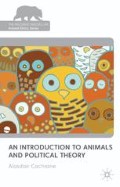Abstract
In the previous two chapters we saw that the rise of utilitarianism led to an increased concern for animals amongst political theorists. While writers such as Hutcheson, Primatt and Bentham all made the link between sentience and justice, the first comprehensive utilitarian theory of animal justice did not arrive until the publication of Peter Singer’s Animal Liberation in the 1970s. However, we also saw how one group of critics regarded utilitarianism to be flawed as a basis to protect animals. These critics argued that utilitarianism was flawed because of its focus on aggregate utility and its failure to offer any absolute prohibitions on the treatment of individual animals. Critics like Tom Regan claimed that we need a theory which recognises the inherent value and rights of individual animals.
Access this chapter
Tax calculation will be finalised at checkout
Purchases are for personal use only
Preview
Unable to display preview. Download preview PDF.
Notes
J. Rawls (1999) A Theory of Justice, revised edn (Oxford: Oxford University Press), p. 53.
P. Carruthers (1992) The Animals Issue: Moral Theory in Practice (Cambridge: Cambridge University Press), pp. 114–15. Robert Elliot offers the same interpretation of Rawls’s argument in
R. Elliot (1984) ‘Rawlsian Justice and Nonhuman Animals’, Journal of Applied Philosophy, 1, 95–106, especially, p. 96.
On this issue of the moral personality of animals, see, for example, M. Bekoff and J. Pierce (2009) Wild Justice: The Moral Lives of Animals (Chicago, IL: University of Chicago Press).
R. Garner (2003) ‘Animals, Politics and Justice: Rawlsian Liberalism and the Plight of Non-humans’, Environmental Politics, 12, 3–22, especially, pp. 16–17.
R. Abbey (2007) ‘Rawlsian Resources for Animal Ethics’, Ethics and the Environment, 12, 1–22, especially, pp. 5–6.
M. Pritchard and W. Robison (1981) ‘Justice and the Treatment of Animals: A Critique of Rawls’, Environmental Ethics, 3, 55–61, especially, p. 56.
For versions of this argument, see D. VanDeVeer (1979) ‘Of Beasts, Persons, and the Original Position’, The Monist, 62, 368–77; Elliot, ‘Rawlsian Justice and Non-human Animals’;
B. Singer (1988) ‘An Extension of Rawls’ Theory of Justice to Environmental Ethics’, Environmental Ethics, 10, 217–31;
M. Rowlands (1997) ‘Contractarianism and Animal Rights’, Journal of Applied Philosophy, 14, 235–47;
T. Regan (2004) The Case for Animal Rights, 2nd edn (Berkeley, CA: University of California Press), pp. 164–71.
B. Barry (1989) Theories of Justice (Hemel Hempstead: Harvester-Wheatsheaf), p. 212.
For such claims, see P. Cavalieri and P. Singer (1993) (eds) The Great Ape Project: Equality Beyond Humanity (London: Fourth Estate).
S. Wise (2002) Unlocking the Cage: Science and the Case for Animal Rights (Oxford: Perseus Press), p. 32;
E. Pluhar (1995) The Moral Significance of Human and Nonhuman Animals (Durham, NJ: Duke University Press), p. 249.
G. Francione (2004) ‘Animals: Property or Persons?’ in C. Sunstein and M. Nussbaum (eds) Animal Rights: Current Debates and New Directions (Oxford: Oxford University Press), pp. 124–5.
G. Francione (1996) Rain Without Thunder: The Ideology of the Animal Rights Movement (Philadelphia, PA: Temple University Press), p. 18.
For more on these points, see A. Cochrane (2009) ‘Do Animals Have an Interest in Liberty?’, Political Studies, 57, 660–79.
R. Garner (2005) The Political Theory of Animal Rights (Manchester: Manchester University Press), p. 44.
On these points, see A. Cochrane (2009) ‘Ownership and Justice for Animals’, Utilitas, 21, 424–42.
R. Dworkin (1973) ‘The Original Position’, University of Chicago Law Review, 40, 500–33, quote, p. 532.
J.S. Mill (1859) On Liberty in J. Gray (ed.) John Stuart Mill: On Liberty and Other Essays (Oxford: Oxford University Press, 1998), p. 14.
Author information
Authors and Affiliations
Copyright information
© 2010 Alasdair Cochrane
About this chapter
Cite this chapter
Cochrane, A. (2010). Liberalism and Animals. In: An Introduction to Animals and Political Theory. The Palgrave Macmillan Animal Ethics Series. Palgrave Macmillan, London. https://doi.org/10.1057/9780230290594_4
Download citation
DOI: https://doi.org/10.1057/9780230290594_4
Publisher Name: Palgrave Macmillan, London
Print ISBN: 978-0-230-23926-5
Online ISBN: 978-0-230-29059-4
eBook Packages: Palgrave Religion & Philosophy CollectionPhilosophy and Religion (R0)

